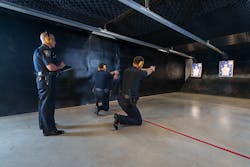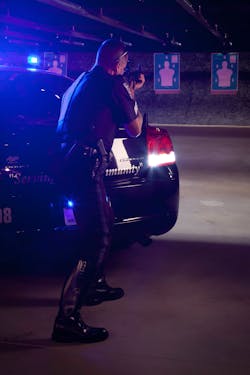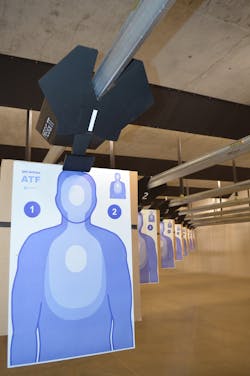What It Takes To Make a Contemporary Range
Don’t get me wrong, back in the old days—in the early 80s—that’s what we had and we did okay.
As a traveling instructor I’ve been to my share of ranges next to water treatment facilities (not a bad smell), sewage treatment centers (not my favorite), corn fields (definitely better) and out in the middle of nowhere. Location is the real issue of ranges, with too many older facilities closed due to noise complaints, which leaves limited locations in which to shoot.
What does a full contemporary range look like? At the minimum, a contemporary facility includes:
- Adequate parking: hard topped to prevent vehicles being mired in inclement weather
- Classroom facilities: learning is multidimensional and a good progression is create the need for the skill in the classroom before heading out to live-fire
- Inside restrooms: we are talking contemporary not adequate here
- Pistol range: out to 50 yards
- Carbine range: out to 100 yards
- Shelters: open pavilion structures or picnic table covers
Range design and structure matters
Modern range design recommends about a mile and a half impact area to the rear of the range. Further, concrete or steel overhead baffles are recommended to further reduce catastrophic accidents. I recently was nonplussed when an agency training supervisor proposed just a 20-foot high, dirt berm which faced a public road less than one-quarter mile away. When I expressed my concern that the rounds would end up going over the top and toward those businesses and potential motor vehicle traffic, the supervisor responded, “We’ll just shoot toward the railroad tracks.” In my experience, that’s not such a good idea.
Though dirt as a backstop can still be used, this leads to “hotspots” in the impact area. These areas of intense projectile impact points can result in previous spent projectiles coming back towards the shooting line. When a shooter fires into the berm, the energy of the incoming bullet dislodges the older projectiles which can and do come back with sufficient energy to cause minor injury (another good reason to always wear eye protection and a hat).
Dirt berms have to be “mined” where the earth is removed, sifted with bullets removed, and then replaced. Dirt berms can have issues with erosion. Frequently when using a dirt backstop during carbine training in the rain or on a soaked berm, we will have mud coming back as far as 25 yards (as I mentioned, eye and head protection mandatory).
Granulated rubber is used as a backstop material in some indoor and outdoor ranges. Hotspots and high impact points can lead to bullet displacement with these are well. Further, the “mining” of the rubber is pretty much a hazmat activity and can be costly. Additionally, outdoor rubber traps can be caught on fire if a vandal or arsonist gets on the property.
Metal backstops are the preferred backstop for both indoor and outdoor ranges. Systems are available which contain any bullets or fragments, even containing the metals in 55 gallon drums for removal/recycle. I’ve shot on some stellar outdoor ranges which use metal backstops such as those at the Federal Law Enforcement Training Center in Glynco, Ga. Definitely your tax dollars at work but their ranges (and they have many) include state-of-the-art outdoor/indoor facilities. These ranges do not require frangible ammunition and can be shot with everything up to .308, depending on the steel involved.
Environmental maintenance at the range is of utmost importance as well, including lead reclamation and removal of lead projectile. “Lead was identified as a hazard and is the most prevalent contaminant at ranges,” says Jim Barthel, president and CEO of MT2, LLC. “Law enforcement uses copper jacketed bullets to contain the lead, so when the bullet impacts, lead becomes available.” Barthel recommends when considering a new range or updating an older one, you must first look at ventilation at the point of shooting. “You’re going to generate lead downrange so do a regular cleaning of ranges between the point of shot to point of where the bullets are collected,” he says. “You want to make sure you’re not stirring up lead dust, so you need to wipe down the target systems monthly or quarterly. If you have a ventilation system, you have to maintain it and clean out filters.” He then recommends looking at operating standards and ensuring users aren’t bringing lead with them outside of the range. “This means making sure that you’re not eating at the range, not smoking, and washing hands afterwards,” he says. Lastly, any solid waste needs to be managed as a potential hazard, too.
Consider the target
Four things to consider when it comes to targets on the range:
Cover Props: Modern ranges must have portable pieces of cover like the “step” barricades in vogue today which can be moved about on the range to create “scramblers” (shooting exercises where the shooter(s) move about the range to different points of cover). Cover should be realistic and 3D. I’ve seen vehicles used, large plastic drain pipe, the options here are based only on imagination but cover must be emphasized in modern police firearms training and it must be as real as we can make it.
Metal Targets: There is really nothing like it. The instantaneous feedback is a fantastic aid in shooter training. There are so many quality steel target companies out there that manufacture everything from standard circle and humanoid plates, knockdowns targets, dueling trees, plate racks, on and on. As long as appropriate stand-off distances are followed (normally 30 feet) from pistol plates backward, and a minimum of 100 yards for carbines. You can use steel targets at darn near point blank range if frangible rounds are used.
Moving Targets: Whether on a track, pulled on a cable or based on a wheeled remote controlled chassis, moving targets are more available and less expensive than ever. Track and cable units move a target or target(s) across a line in front of the shooter. Remote “robot” movers can be remotely maneuvered by the instructor to come out from cover, move towards, away or erratically in front of the shooter. A simple mover can be pulled by an instructor with a cord. Though rudimentary, they still make the officer think, move and respond versus planting in one spot (growing roots in a gunfight is not a good thing).
Turning Targets: The standard here is a pneumatic system but there are some newer battery operated designs. Systems can be pricey and locked down into fixed lines of targets but the latest and greatest allow the instructor to actuate one or more targets with a remote control while out on the range. I’ve had the opportunity to shoot on pneumatic steel ranges where targets pop up or flip out and they take training to a new level. There are portable systems in both the pneumatic and portable battery categories which allow targets to be moved around a range for scrambler type courses and actuated remotely by a firearms instructor.
When it comes to today’s ranges, each one should feature programmable turning targets so law enforcement can train effectively in “friend or foe” situations, says Read. In addition, they should include wireless target control devices where the trainer can be in the range with the students; bullet traps that allow for tactical training; patrol lights, sound systems, dimmable lighting in the range to simulate real-life situations; and if possible, a door to allow patrol cars and motorcycles into the range so officers can train with the actual tools they use every day.
Read recommends discussing range options with a range equipment provider as early in the process as possible when designing a new range or updating a current one. “We are the experts in the field and can assist with the design of the range and work with the architect engineers and general contractors to ensure the range is designed and built properly to allow for the desired training needs,” he says.
Though we used to shoot into dirt piles with little or no facilities, we shouldn’t be doing that now. Modern, progressive agencies understand that the quality of training facilities and trainers directly impacts to performance on the street. Standing in one spot, shooting on a paper target from a known distance and shooting meaningless/minimum performance qualifications once a year does not properly prepare the modern police officer for armed encounters on the street. Falling into the “We always did it this way” trap at outdated facilities gets our people hurt or worse. We must progress, we must advance—we owe it to our officers.
Bring the range to you
Technology advancements have helped law enforcement practice even when it’s not possible to make it to a physical range.
David Avgikos, the president of Digimation, which develops and manufactures the DART range simulator, notes that as a developer of training and simulation systems, he is often asked if simulated training is meant to replace real-world training. “Of course, the answer is no,” he says. “Simulation is not meant to take the place of hands-on practice in the real world. However, real-world training often has significant limitations which can prevent it from occurring as often as one would like.” Simulated training is designed to fill the gaps left by the limitations of real-world training, he says.
“We speak with law enforcement trainers every day who say that their officers make it to the range twice a year,” says Avgikos. “When asked if twice a year is enough, the answer is always “no”. Some of the reasons for limited range time include the logistics of getting to a range, the expense, weather, as well as a lack of enthusiasm for range practice.”
Simulated training can occur more often, with more intensity, at a lower cost, and in a safer environment. Firing range simulators offer substantial benefits when used to augment live-fire training.
About the Author
Kevin Davis
Tactical Survival Contributor
Kevin R. Davis retired from the Akron Police Department after 31 years with a total of 39 years in law enforcement. Kevin was a street patrol officer, narcotics detective, full-time use of force, suspect control, and firearms instructor, and detective assigned to the Body Worn Camera Unit. Kevin is the author of Use of Force Investigations: A Manual for Law Enforcement, and is an active consultant and expert witness on use of force incidents. Kevin's website is https://kd-forcetraining.com/

Adrienne Zimmer
Editor
Adrienne Zimmer was the Editor of Law Enforcement Technology magazine, a monthly business-to-business publication that covers technology trends and best practices for public safety managers from 2017 to 2019. LET is part of Officer Media Group, which also publishes Law Enforcement Product News and Officer.com. Adrienne has been in publishing since 2013.




